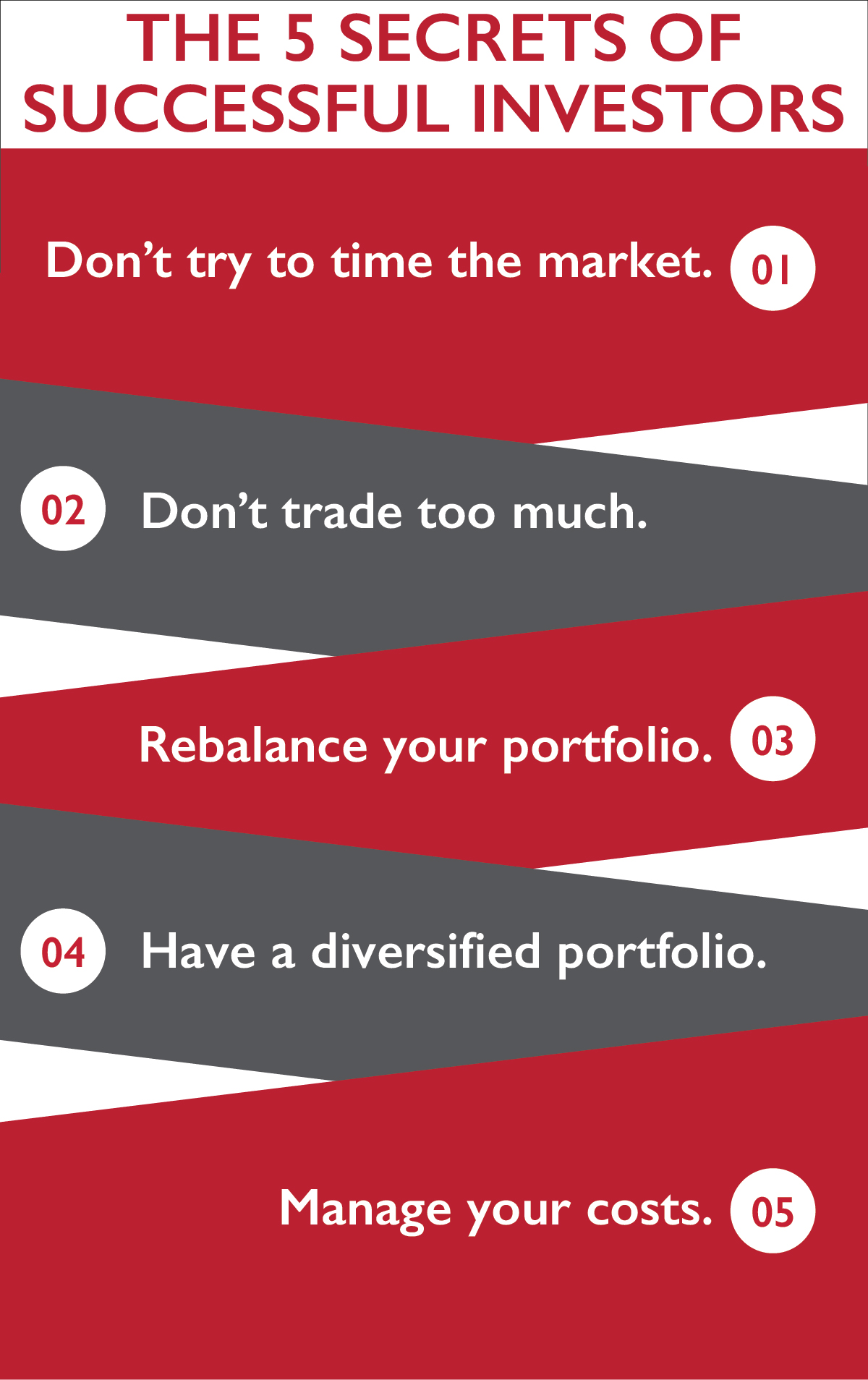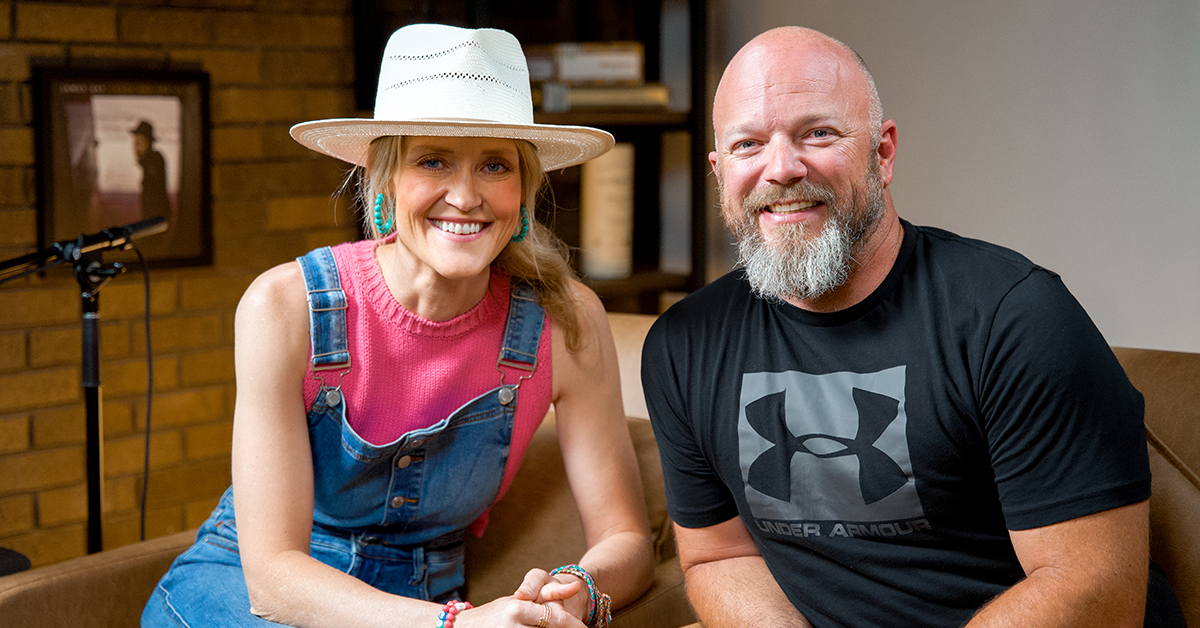
Timing the market. Trading. Rebalancing. If you’re investing, chances are you’re taking part in one or more of these activities. But are you doing any of them right?
For the latest episode of Common Cents on the Prairie™, I joined forces with Sarah Madison, Chartered Financial Analyst and Portfolio Manager with First National Wealth Management, to help you become the best investor. With more than 30 years of experience in money management between us, we compiled the top five secrets to successful investing:

Now you know the secrets of successful investors, but do you know how to apply them to your portfolio? To help you out, Sarah and I broke them down for you! You can read all about the five secrets below, watch the entire podcast episode, or listen to Common Cents on the Prairie™ wherever you stream your podcasts.
Secret #1: Don’t try to time the market.
Timing the market is when an investor buys or sells an investment for a select amount of time so they can own or not own it during expected price changes. In theory, timing the market sounds like an obvious way to generate added returns because we know stocks are going to go up and down over time.
But the problem is that people don’t do it well (including most professionals). Plus, being out of the market at the wrong time can really hurt your investment performance; the market is positive 75% of the time over calendar years, so that upward momentum works against you anytime you’re going to be out of it.
So what drives us to try to time the market? We can blame our instincts. Our fight-or-flight response is useful in keeping us alive, but not very helpful when it comes to investing. We feel losses and down days more than we feel up days, so our natural instinct is to avoid the down days at all costs.
To make matters worse, trying to time the market means you have to get it right twice: first when you get out of the market and then when you get back in. However, it’s challenging enough to get one side of that right, let alone both.
According to research on missed “best days,” missing just one best day reduces the growth of $1,000 dollars over a 30-year time frame by over $2,000 — and that single best day can and often does happen during the worst days in the market. Do that same math with a larger account balance and the problem is significant.
 Instead of timing the market, we tell most clients to consistently invest on a set schedule, whether the market is good, bad, at an all-time high, or at an all-time low. This method, also known as dollar-cost averaging, takes the emotion out of investing and follows the old adage that time in the market is more important than timing the market.
Instead of timing the market, we tell most clients to consistently invest on a set schedule, whether the market is good, bad, at an all-time high, or at an all-time low. This method, also known as dollar-cost averaging, takes the emotion out of investing and follows the old adage that time in the market is more important than timing the market.
Secret #2: Don’t trade too much.
A large custodian did a study looking at decades of performance on millions of accounts. They grouped the best performing and worst performing accounts and surveyed investors to find out if there were any commonalities; the worst performing group had traded the most often, while the best performing group had all forgotten they had an account!
There’s also a study of more than five million people in which Fidelity Investments (2021) found that women performed better at investing fairly consistently. This was because, as a group, the women traded half as often as the men in the study.
The research shows clearly, then, that less trading equals better investing. And it’s also important to remember that there are costs and commissions associated with trading, along with tax consequences when you sell something in a taxable account. So by trading more often, you’re increasing your costs and eroding your gains — for more on that, see Secret #5.
Secret #3: Rebalance your portfolio.
Rebalancing your portfolio means that you have set target weights or percentages for your investments, and you periodically make trades to bring them back to those targets.
 Wait, didn’t I just tell you not to trade very much? Well, the key to rebalancing is to do it sparingly — once a year on a specified date, like on your birthday.
Wait, didn’t I just tell you not to trade very much? Well, the key to rebalancing is to do it sparingly — once a year on a specified date, like on your birthday.
We also help our clients rebalance when their weights exceed a certain threshold from the target, for which research says 5% is the optimal number.
The markets can be volatile, and you can use that volatility to your advantage. Rebalancing will bring you back to your target weights so that what performed relatively well is being sold back down to target and what underperformed is being purchased to bring up to that target.
If you’re not interested in rebalancing yourself, there are other options. With a lot of retirement plans, you can set up automatic rebalancing. Of course, the alternative is to hire a professional like our firm to do it for you.
Secret #4: Have a diversified portfolio.
The market does not compensate you for the risk of having a lot of your wealth in one thing. Concentrations are shockingly common, but they are not a risk that you’re rewarded for taking.
If something happens to that one company or industry, such as a law change or a management change, it could really hurt your investments. On the other hand, research shows that diversification can add 1% of return a year.
In some instances, concentrations can create a lot of wealth, but that wealth is maintained through diversification. So if you haven’t already, go diversify that portfolio of yours!
Secret #5: Manage your costs.
The returns you receive from your investments are what’s left over after you pay all costs, including taxes. So, costs can erode away your investment returns when they’re not adding any value for you.
The money saved on those costs, whether they be taxes, commissions, or what you’re paying on your investments, is just as real and tangible as money earned through an elaborate investment plan. Unsurprisingly, the research shows that the lower your costs, the more likely you are to be one of the top investment performers.
Now, I know what you’re thinking: it costs money to hire a professional manager like us. Does that mean you should cut costs by not hiring an advisor?
That depends. Research shows that financial advisors whose interests are aligned with their clients’ add a great deal of value. It’s over time and lumpy, but advisors more than pay for themselves by helping you implement these five secrets — on top of helping you manage your financial plan and coordinate your estate and tax planning.
You might be surprised to know that I use an advisor for my own investments; it’s because I know I have biases and emotional baggage with money, so I work with someone to save me from myself. That’s more than worth the fee I pay.
And if you have a financial advisor but think you aren’t paying them anything, well, that’s simply not true. Unless the Salvation Army has started an investment management division that I’m not aware of, there’s always a cost associated with working with an advisor.
So if your advisor has said that, or you don’t have an advisor and don’t know where to start, reach out. We follow the fiduciary standard, and we’re happy to help.
Any comments, insights, or strategies discussed in this article are intended to be general in nature and, therefore, may not be suitable for you and your situation, whatever that may be. Before acting on anything written here, please consult with your attorney, CPA, and/or your financial advisor.






